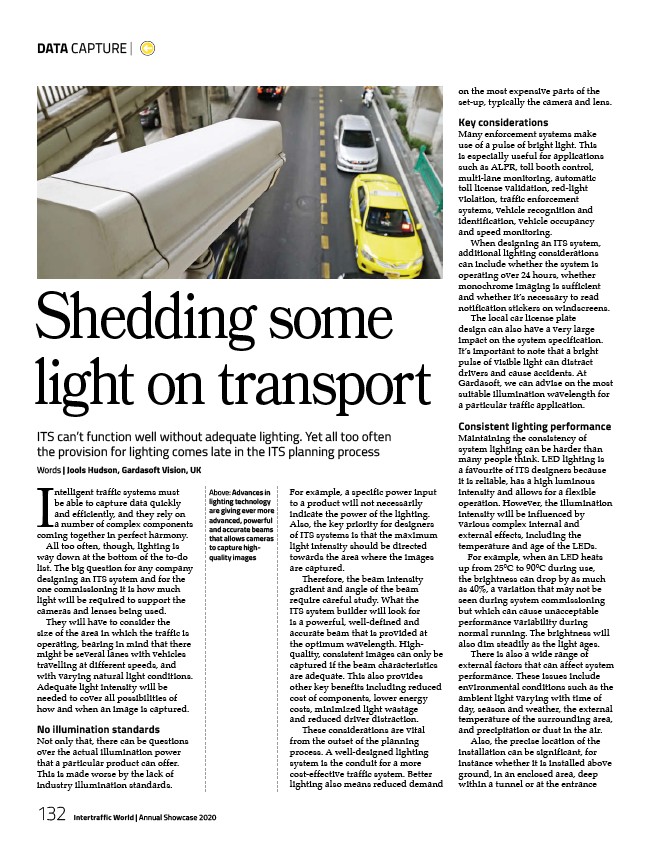
DATA CAPTURE |
ITS can’t function well without adequate lighting. Yet all too often
the provision for lighting comes late in the ITS planning process
Words | Jools Hudson, Gardasoft Vision, UK
Above: Advances in
lighting technology
are giving ever more
advanced, powerful
and accurate beams
that allows cameras
to capture highquality
132 Intertraffic World | Annual Showcase 2020
images
Intelligent traffic systems must
be able to capture data quickly
and efficiently, and they rely on
a number of complex components
coming together in perfect harmony.
All too often, though, lighting is
way down at the bottom of the to-do
list. The big question for any company
designing an ITS system and for the
one commissioning it is how much
light will be required to support the
cameras and lenses being used.
They will have to consider the
size of the area in which the traffic is
operating, bearing in mind that there
might be several lanes with vehicles
travelling at different speeds, and
with varying natural light conditions.
Adequate light intensity will be
needed to cover all possibilities of
how and when an image is captured.
No illumination standards
Not only that, there can be questions
over the actual illumination power
that a particular product can offer.
This is made worse by the lack of
industry illumination standards.
For example, a specific power input
to a product will not necessarily
indicate the power of the lighting.
Also, the key priority for designers
of ITS systems is that the maximum
light intensity should be directed
towards the area where the images
are captured.
Therefore, the beam intensity
gradient and angle of the beam
require careful study. What the
ITS system builder will look for
is a powerful, well-defined and
accurate beam that is provided at
the optimum wavelength. Highquality,
consistent images can only be
captured if the beam characteristics
are adequate. This also provides
other key benefits including reduced
cost of components, lower energy
costs, minimized light wastage
and reduced driver distraction.
These considerations are vital
from the outset of the planning
process. A well-designed lighting
system is the conduit for a more
cost-effective traffic system. Better
lighting also means reduced demand
on the most expensive parts of the
set-up, typically the camera and lens.
Key considerations
Many enforcement systems make
use of a pulse of bright light. This
is especially useful for applications
such as ALPR, toll booth control,
multi-lane monitoring, automatic
toll license validation, red-light
violation, traffic enforcement
systems, vehicle recognition and
identification, vehicle occupancy
and speed monitoring.
When designing an ITS system,
additional lighting considerations
can include whether the system is
operating over 24 hours, whether
monochrome imaging is sufficient
and whether it’s necessary to read
notification stickers on windscreens.
The local car license plate
design can also have a very large
impact on the system specification.
It’s important to note that a bright
pulse of visible light can distract
drivers and cause accidents. At
Gardasoft, we can advise on the most
suitable illumination wavelength for
a particular traffic application.
Consistent lighting performance
Maintaining the consistency of
system lighting can be harder than
many people think. LED lighting is
a favourite of ITS designers because
it is reliable, has a high luminous
intensity and allows for a flexible
operation. However, the illumination
intensity will be influenced by
various complex internal and
external effects, including the
temperature and age of the LEDs.
For example, when an LED heats
up from 25°C to 90°C during use,
the brightness can drop by as much
as 40%, a variation that may not be
seen during system commissioning
but which can cause unacceptable
performance variability during
normal running. The brightness will
also dim steadily as the light ages.
There is also a wide range of
external factors that can affect system
performance. These issues include
environmental conditions such as the
ambient light varying with time of
day, season and weather, the external
temperature of the surrounding area,
and precipitation or dust in the air.
Also, the precise location of the
installation can be significant, for
instance whether it is installed above
ground, in an enclosed area, deep
within a tunnel or at the entrance
Shedding some
light on transport